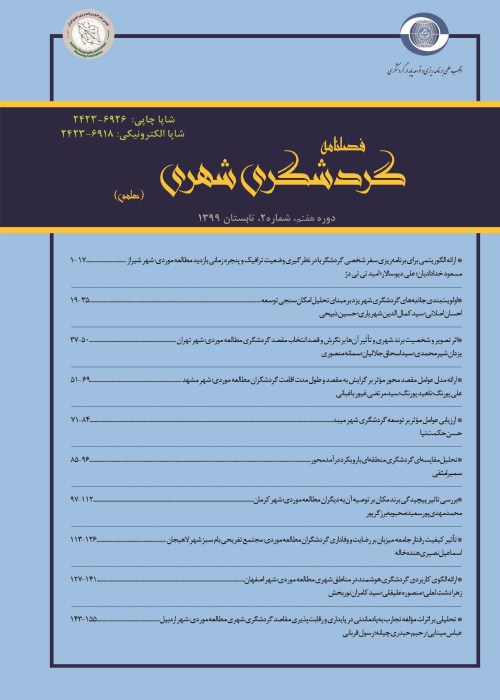The relationship between crisis management and community resilience in tourism destination at corona crisis(Case study: Hamedan city)
Covid-19 virus was reported in early January 2020 by the World Health Organization in China. The virus spread rapidly in the Wuhan region of China, and was initially largely ignored by political leaders around the world. Within a few weeks, the disease spread beyond China. Covid-19 has plunged the world into an unforeseen health crisis that has had a profound impact on communities. Tourism destinations are among the sectors that have received the most negative impact from this crisis. Given the severity of the outbreak of crises over the past decade, and with increasing access to information about these events, it has exacerbated crises that have a direct impact on the tourism industry. Tourism destinations are particularly prone to the consequences of changing circumstances, as they face an increasing number of uncontrollable events. Most local communities are affected on a large scale by the social effects of crises. And after the crisis, long-term sustainable reconstruction depends on economic, social, environmental and local considerations in the recovery strategy. In addition, communications and tourism leadership are essential in the improvement process. Given this, qualitative research is needed to interpret crises at a deeper level. Several key studies on the process of crisis management and tourism-related procedures have been conducted in the context of the resilience process. However, there is a need for further research on the relationship between resilience, tourism crisis management and sustainability, as well as destination development and management from a resilience perspective. In particular, more research is needed to investigate the catastrophic event because it is directly related to the stages of the coping process. The lack of relevant research in the field of tourism has led to the identification of the relationship between crisis management practices and local resilience responses to address the gaps mentioned in the literature. The purpose of interpreting these relationships is to identify how crisis management decisions are made that can affect how the local community (Hamedan city) responds to a natural disaster.
The present study is fundamental-applied in terms of purpose and is considered qualitative with an exploratory orientation. The technique used is grounded theory. In the present study, the statistical population of the study included professors and university experts, tourism business owners and tourism activists in the private and public sectors in the city of Hamadan. Sampling was theoretical for 13 people using non-probabilistic methods of purposive and snowball sampling. Thus, in the fall of 1399, first, according to the researchers' knowledge and considering the research objectives, a semi-structured interview was conducted with selected experts who were qualified to answer the questions, and then they introduced other experts to continue sampling. All interviews were recorded and the average interview time was 45 minutes. Thirteen interviews were conducted, but no new concept of data was obtained from the tenth interview. However, to ensure theoretical saturation, three more interviews were conducted, and given that no new concept and class of interview data failed, theoretical saturation achieved. In order to analyze the data, the qualitative content analysis method was used and at the same time with data collection, ATLAS-TI software was used. With this description, the way to get the initial codes is such that each of the interviews, after implementing their text, is carefully examined and the main message or key concepts of each phrase are extracted.
After conducting the interviews and using other sources, the researchers obtained more than 84 original codes, which were extracted by removing irrelevant codes and making comparisons, finding similarities and differences, and a total of 56 concepts were extracted that were extracted in the form of 12 main categories and 2 central categories and theoretical saturation was obtained. In the following, according to the research findings, as well as the space and modeling of Atlas-TI software, the research model is presented, which shows the general ratio of concepts, categories and dimensions in this research. The model (framework) of crisis management and community resilience in the tourism destination includes two central categories in the form of two time frameworks including creating resilience during crisis management and managing the continuous resilience process of the Hamedan tourism community, in which the relevant dimensions (main category) are defined. Dimensions of creating resilience in times of crisis include perceptions of emotions, perceptions of danger and confrontation with it, the ability to adapt to change and innovation, creating a sense of security, sympathy of tourism stakeholders and media support for tourism. Dimensions of continuous resilience management process related to resilience of Hamedan tourism community include tourism insurance coverage, national and local tourism crisis management, development of information and communication technology and communication channels in tourism, content creation and production of tourism knowledge and learning and virtual education of tourism. According to the related concepts provided, it can be defined and provided for other tourism purposes.
The results of this study argue that interpreting the host community's response to crisis management through resilience allows decision makers to fully understand the effects of the Covid-19 pandemic crisis on society and the tourism industry. This study proposes an integrated path for crisis management and community resilience to be used to manage crises and the sustainability of the tourism community.
- حق عضویت دریافتی صرف حمایت از نشریات عضو و نگهداری، تکمیل و توسعه مگیران میشود.
- پرداخت حق اشتراک و دانلود مقالات اجازه بازنشر آن در سایر رسانههای چاپی و دیجیتال را به کاربر نمیدهد.



